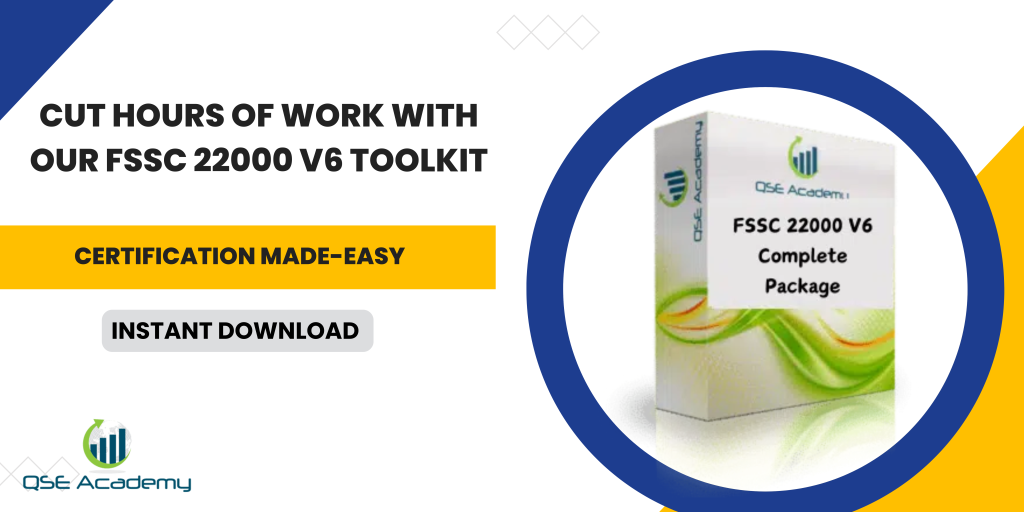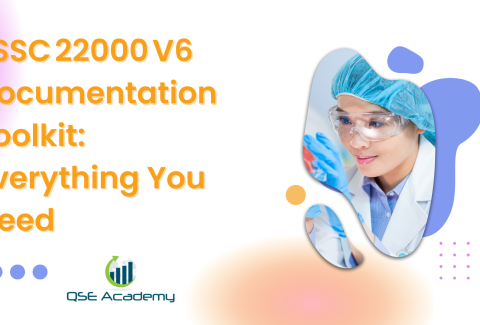Implementing FSSC 22000 V6: 90‑Day Action Plan
A Clear Roadmap Makes Certification Achievable
Most organizations start their FSSC 22000 V6 journey with the same questions:
Where do we begin? How long will it take? What should we prioritize?
Implementation can feel overwhelming until the work is organized into a logical sequence. That’s where a structured 90-day action plan changes everything. It breaks the certification journey into predictable tasks, timelines, and milestones.
At QSE Academy, we’ve guided companies of all sizes through this process. The most successful ones weren’t always the largest or most experienced — they simply followed a clear, realistic plan.
This guide walks you through that plan step by step so you can move from uncertainty to certification readiness with confidence.
Understanding the 90-Day Implementation Structure
This action plan follows the natural lifecycle of implementing an FSSC 22000 V6-compliant food-safety management system.
The 90 days are divided into six logical phases:
| Phase | Duration | Focus |
|---|---|---|
| Phase 1 | Weeks 1–3 | Gap analysis, scope, leadership roles |
| Phase 2 | Weeks 4–6 | Documentation and planning |
| Phase 3 | Weeks 7–9 | Training and competence building |
| Phase 4 | Weeks 10–12 | Implementation, evidence, and verification |
| Phase 5 | Weeks 13–14 | Management review and audit preparation |
| Phase 6 | Weeks 15–16 | Certification audits and corrective actions |
Each phase builds on the previous one. The goal is simple: create momentum and maintain it.
 Phase 1 (Weeks 1–3): Gap Analysis and Scope Definition
Phase 1 (Weeks 1–3): Gap Analysis and Scope Definition
Everything starts with clarity. Before writing documents or planning training, you need to understand where the organization stands today.
During this phase:
- Conduct a clause-by-clause gap analysis against:
- ISO 22000:2018
- ISO/TS 22002-x (based on your category)
- FSSC 22000 V6 additional requirements
- Define your certification scope:
- Products
- Processes
- Sites
- Boundaries
- Form your Food-Safety Team and confirm leadership responsibilities.
Create an Action Matrix summarizing findings:
| Requirement | Status | Gap Summary | Action Needed | Responsible | Deadline |
Pro Tip: Prioritize gaps that affect safety, legal compliance, and audit readiness first.
Phase 2 (Weeks 4–6): Documentation and Project Planning
Once the scope and gaps are clear, documentation becomes the foundation of your system.
During this phase:
- Build or adapt your:
- Food-Safety Manual
- PRP procedures
- Operational procedures
- Required forms and records
- Develop a project plan showing:
- Milestones
- Responsible persons
- Deadlines
- Establish document control and communication channels.
Focus documentation on operational reality, not theory.
Common mistake: Writing documents no one uses. Procedures should reflect what already happens or what will happen — not ideal scenarios.
Phase 3 (Weeks 7–9): Training and Competence Building
Certification depends on people—not just documents.
During this phase:
- Train employees based on role and responsibility.
- Build awareness of hazards, hygiene, allergens, and monitoring.
- Train the Food-Safety Team on:
- HACCP
- internal auditing
- risk-based thinking
- Create a Competence Matrix to demonstrate evidence of skill.
Keep sessions short, relevant, and practical.
This phase supports food-safety culture development by building shared understanding and accountability.
Phase 4 (Weeks 10–12): Implementation, Records, and Verification
This is when the system becomes operational.
During this phase:
- Begin using all procedures and forms.
- Record monitoring, inspections, calibrations, and verifications.
- Validate CCPs and PRPs.
- Conduct traceability and recall simulations.
- Schedule and complete an internal audit covering all elements.
Evidence matters. Every activity must produce usable records.
Pro Tip: Run a mock audit during this phase to identify issues early.
Phase 5 (Weeks 13–14): Management Review and Certification Readiness
Now the system has evidence, training, and implementation behind it — it’s time to step back and evaluate it.
During this phase:
- Conduct a full management review that includes:
- Internal audit results
- KPI performance
- Nonconformities and corrective actions
- Training effectiveness
- Food-safety objectives
- Resource needs
- Ensure required records, manuals, and evidence are organized and accessible for the auditor.
This phase confirms alignment between leadership, operations, and certification goals.
Phase 6 (Weeks 15–16): Certification Audit Execution
With preparation complete, it’s time for certification.
- Stage 1 Audit: Review documentation and system preparation.
- Stage 2 Audit: Operational verification, interviews, and record review.
Address any nonconformities within the agreed timeframe.
A brief real example:
A mid-size snack manufacturer followed this exact approach and achieved certification in less than 90 days. Their success came from consistent execution—not a large budget or a large team.
Optimizing the System After Certification
Certification is a milestone—not the finish line.
To sustain compliance:
- Continue internal audits at planned intervals.
- Refresh training as roles, products, or processes evolve.
- Track food-safety objectives and improvement actions.
- Update PRPs, HACCP plans, and procedures when needed.
- Prepare for surveillance and recertification audits proactively.
A living system adapts and improves over time.
FAQs — Quick Clarifications for Implementers
How realistic is the 90-day timeline?
It’s realistic when leadership is committed, scope is clear, and resources are allocated.
Do we need a full Food-Safety Team from day one?
Yes — even a small team can manage implementation when roles are defined and training is provided.
Can implementation be done internally?
Yes — especially when supported by templates, checklists, and structured guidance.
Conclusion — A Practical Path to Certification
A 90-day implementation plan simplifies FSSC 22000 V6 and turns the journey into a structured, manageable process.
With the right approach, the system becomes more than a certification requirement — it becomes a practical framework for control, consistency, and improvement.
If you’re ready to begin, download the FSSC 22000 V6 90-Day Action Plan Template and use it to guide implementation from day one through audit readiness.
Melissa Lavaro is a seasoned ISO consultant and an enthusiastic advocate for quality management standards. With a rich experience in conducting audits and providing consultancy services, Melissa specializes in helping organizations implement and adapt to ISO standards. Her passion for quality management is evident in her hands-on approach and deep understanding of the regulatory frameworks. Melissa’s expertise and energetic commitment make her a sought-after consultant, dedicated to elevating organizational compliance and performance through practical, insightful guidance.








